Sights of Kaluga
Along Ulitsa Kirova
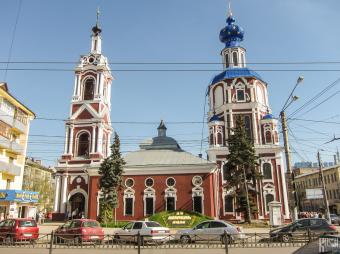
Beheading of St John the Baptist Church
- 30 Ulitsa Moskovskaya
Standing at the intersection of Ulitsa Moskovskaya with Ulitsa Kirova is the pretty Beheading of St John the Baptist Church. The church was built in 1735 in the baroque style but was later damaged in a fire in 1754 after which restoration work was carried out and new side-altars were added. In 1784 a three-tier bell tower was added. It was closed in the 1920s and subsequently used as a store only being returned to the Church in 1995. Read more »
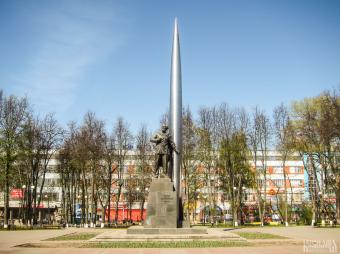
Konstantin Tsiolkovsky Monument
- Ploschad Mira
The start of Ulitsa Kirova is formed with Ploschad Mira which has in its centre a monument to Kaluga’s most famous citizen – Konstantin Tsiolkovsky. The monument was unveiled in 1958 on the 100th anniversary of the scientist’s birth. It depicts Tsiolkovsky in bronze confidently striding forward on top of a granite pedestal. Behind the statue there stands an 18 metre stainless-steel rocket. Read more »
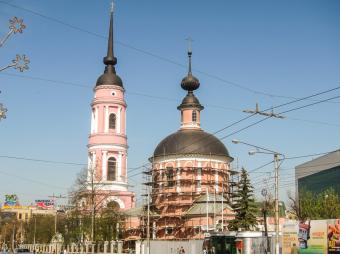
Myrrhbearers' Church
- 21 Ulitsa Kirova
The Myrrbearers' Church was built between 1798 and 1804 to replace an earlier version of the church which was destroyed by fire. The dark pink church consist of a rotunda topped with a dome attached via a vestibule to a three-tier bell tower. The bell tower was built between 1818 and 1842 and is also round in form. The church was closed in 1930 and used as a store, only being returned to the Church in 1990. Read more »
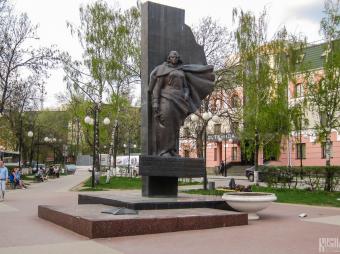
Nurses Monument
- Skver Medsestyor, between 19 and 21 Ulitsa Kirova
Just before Myrrhbearers’ Church is the small Skver Medsestyor (Nurses Public Gardens) which has a monument dedicated to courage of the nurses of the Second World War. It depicts a statue of a nurse standing against a large plinth. Also located in the gardens are some benches and a fountain. Read more »
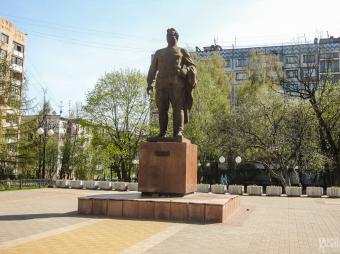
Sergey Kirov Monument
- in front of 76 Ulitsa Kirova
Although a statue of Sergey Kirov has stood on the street which bears his name since 1947, this statue is the second of its type and was unveiled in 1977. The cast iron statue depicts the revolutionary holding his coat and standing on a marble pedestal. The stature is located in a small square almost opposite the start of Pereulok Kirova. Read more »
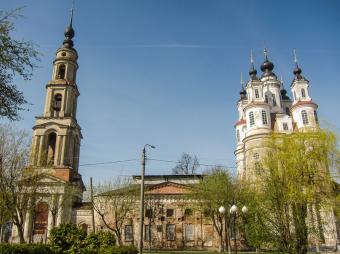
Ss Cosmas and Damian's Church
- 177/16 Ulitsa Suvorova
The beautiful Ss Cosmas and Damian's Church was built in 1794 in the baroque style of the famous architect Francesco Bartolomeo Rastrelli. Its form is unusual with the main body of the church being topped with five elongated tiered tholobates each with a small black dome. Attached to this is a four-tier bell tower which was built in 1797. It was closed in 1937 and only returned to the Church in 1992. Restoration work is in process. Read more »
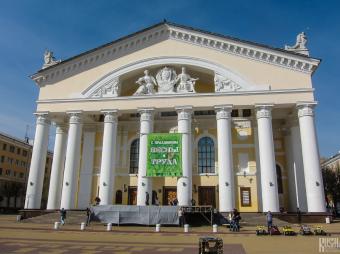
Theatre Square and Boulevard
- Teatralnaya Ploschad and Teatralny Bulvar
Located approximately half-way down Ulitsa Kirova is Teatralnaya Ploschad (Theatre Square) where the Kaluga Region Drama Theatre stands among fountains and trees. On the other side of Ulitsa Kirova is Teatralny Bulvar (Theatre Boulevard) which is a pedestrian area comprising the first block of Ulitsa Teatralnaya. Here you can find many cafes and souvenir shops as well as several sculptures, including one of a man who resembles Konstantin Tsiolkovsky staring up into space. … Read more »
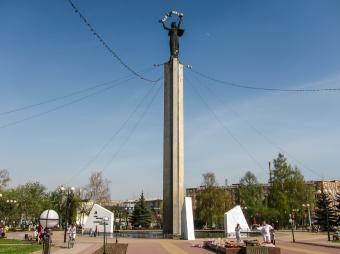
Victory Monument and Eternal Flame
- Ploschad Pobedy
The end of Ulitsa Kirova is marked with Ploschad Pobedy (Victory Square). Located in the centre of the square is a Victory Monument comprising a 30 metre obelisk which was erected in 1966 on the 25th anniversary of the liberation of Kaluga. In 1970 an eternal flame was added and in 1975 the obelisk was topped with a new monument, depicting a representation of Mother Russia holding a ribbon, symbolising the River Oka, in one hand and a satellite in the other. On the boulevard… Read more »
Around Berezuisky Ravine
Epiphany Church
- 23 Ulitsa Kutuzova
The Epiphany Church dates from 1735-1746. The yellow church was built in the classical style and it comprises a large tholobate and dome on a cubic building. This part of the church was attached to a three-tiered bell tower in 1832. The church was closed in 1934 and used as an archive. It is now in a poor condition and in need of extensive restoration work on both the main building and the bell tower. Read more »
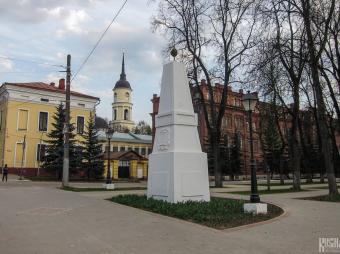
Golden Alley
- Ulitsa Karla Marksa
Running in between Berezuisky Ravine and Ulitsa Marksa is a boulevard known as Zolotaya Alleya (Golden Alley) - a favourite place for strolling among locals. It was here that Kaluga's kremlin once stood. In addition to the Pushkin Monument and the Monument to Victims of Political Repression in the boulevard itself, there are also several old buildings located nearby, including the 18th century Public Office and the 19th century Nobility Assembly and Governor's House. Read more »
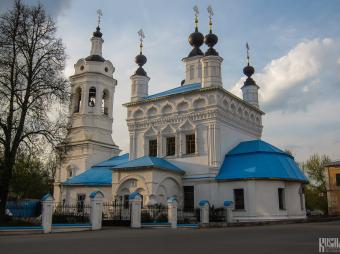
Intercession Church
- 4 Ulitsa Marata
The beautiful Intercession Church was built near the edge of Berezuisky Ravine in around 1687 to replace an older wooden version. It is Moscow baroque in style with an elaborately decorated cube building topped with five black domes. A bell tower was built onto the main body of the church in the 18th century. The church was closed in 1930 and was briefly used as a concert hall until it was finally returned to the Church in 1994. Read more »
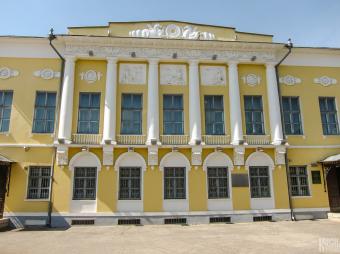
Kaluga Region Museum of Art
- 104 Ulitsa Lenina
- http://artmuseum.kaluga.ru
- 10:00 - 18:00. Closed on Mondays and the last Friday of the month.
The Kaluga Region Museum of Art was opened in 1918 in the house of local doctor Nikanor Vasiliev, who left his art collection to the city. Later the museum received more works of art which were confiscated from nationalised estates. Several works of art were lost during the Nazi occupation as they couldn't be evacuated in time. In 1969 the museum moved to its present location in the early 19th century Bilibin Estate. Its exhibits include icon removed from local churches, Russian… Read more »
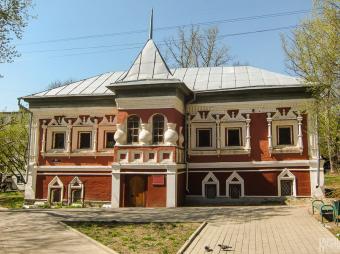
Korobov Chambers
- 88 Ulitsa Plekhanova
The house known as Korobov Chambers takes its name from its owner who was a merchant and it has the honour of being the oldest house in Kaluga, dating from 1697. The small red and white building is a pretty example of what is known as Moscow Naryshkin baroque. Today it serves as an exhibition centre of the Kaluga Regional Museum. Read more »
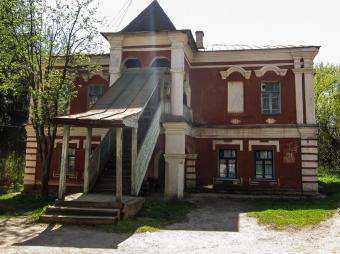
Makarov Chambers
- 16 Ulitsa Pushkina
Located next to the Kaluga Regional Museum is the building known as Makarov Chambers which was constructed in 1728. Like the Korobov Chambers, the Makarov Chambers are named after their previous owner. Today rather surprisingly the building is still used for its original purpose - accommodation, making it the oldest inhabited building in Kaluga. Read more »
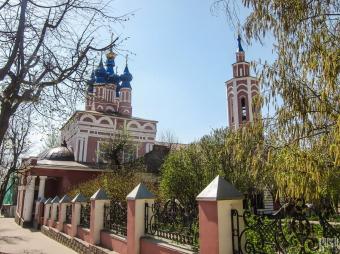
Nativity of Virgin Mary Church
- 106 Ulitsa Lenina
This pretty pink church was built in 1685 to replace an earlier wooden version. It comprises a cube building decorated with columns and topped with five small blue domes on high tholobates. Attached to this is a four-tier octagonal bell tower. The church was closed in the 1920s and used as a warehouse and a cinema; its domes being removed in the process. In 2004 it was returned to the Orthodox Church and re-consecrated after restoration work in 2009. Read more »
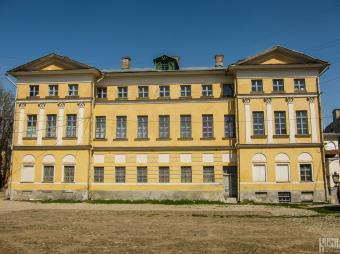
Regional Museum of the Kaluga Region
- 14 Ulitsa Pushkina
- http://www.kokm.ru
- 10:00 - 17:00. Closed on Mondays and the last Friday of the month.
The Regional Museum of the Kaluga Region was established in 1897 and since 1992 it has been located in what was once the city estate of the Zolotarev family. The estate dates from the early 19th century and includes a mansion, a large courtyard and several auxiliary buildings. The museum now has exhibitions on the history of Kaluga Lands, starting with ancient history up to the Russian Revolution and the Second World War. It also has displays on the nature of the Kaluga Region… Read more »
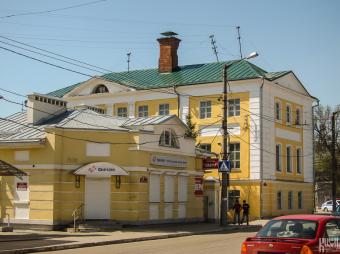
Shamil's House
- 4 Ulitsa Pushkina
In 1859 Imam Shamil, the leader of the anti-Russian resistance during the Caucasian War, was captured. After his capture he was sent to meet Emperor Alexander II who exiled him to Kaluga. It was in this late 18th century mansion once owned by the merchant Ivan Bilibin that Shamil served his exile in Kaluga. Shamil remained in the city until 1868 when he was permitted to move to Kiev where the climate was more to his liking. Read more »
St George's Cathedral
- 14 Ulitsa Baumana
This cathedral dedicated to St George is usually also referred to in Russian as the Higher St George's Cathedral as it is located on the top of the ravine. It was built as a church in 1701 in the Moscow baroque style, decorated with kokoshniks, to replace an earlier wooden version. Its pinkish-red colour with blue domes makes it rather unusual and pretty. Although it was closed for a short period in 1940, it served as the city's eparchial cathedral from 1926 to 1999. The… Read more »
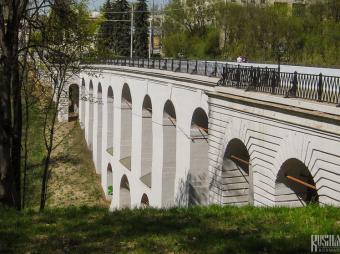
Stone Bridge
- over Berezuisky Ravine
One of Kaluga's most famous sights is the Stone Bridge which connects Ulitsa Pushkina with Ulitsa Bazhenova across the Berezuisky Ravine. Amazingly this Roman-style viaduct was first opened in 1777 and although it was closed for restoration between 2009 and 2010, it is still operational despite the massive increase in traffic it has seen. At almost 160 metres wide, 20 metres tall and comprising 15 large arches, the bridge is the largest stone viaduct in Russia. Read more »
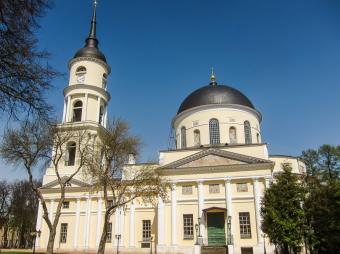
Trinity Eparchial Cathedral
- Park of Culture and Rest
Located within the main city park among its ancient oak trees, is the Trinity Cathedral which now serves as the eparchial cathedral of the Kaluga and Borovsk Eparchy. It was built between 1786 and 1819 in the classical style with a pillar-less building topped by a large dome with a 17 metre diameter and attached to a four-tier bell tower. The cathedral was closed in 1924, damaged in the war and then returned to the Church in 1991. After undergoing restoration work the cathedral was… Read more »
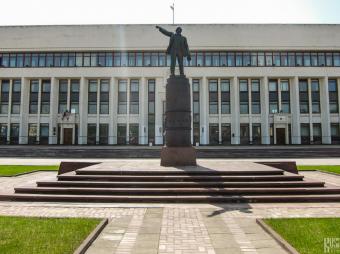
Vladimir Lenin Monument and Trading Rows
- Ploschad Stary Torg
Located on Ploschad Stary Torg (Old Trade Square) is the city's monument to Vladimir Lenin. In this statue Lenin is depicted defiantly pointing ahead but is somewhat dwarfed by the massive Soviet-style Kaluga Region Administration Building behind him. Opposite Lenin are the city's famous trading rows - a calling card of the city, but currently undergoing extensive restoration work. Read more »
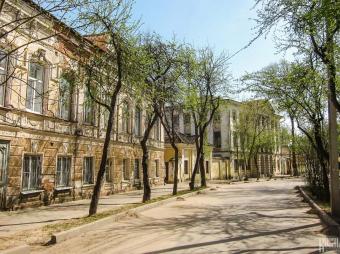
Voskresenskaya Ulitsa
- Voskresenskaya Ulitsa
One of the prettiest streets in Kaluga is Voskresenskaya Ulitsa (Resurrection Street) as many of its 19th century buildings have survived. This street was once the residence of Kaluga's elite, including nobles and rich merchants. Also on the street is a monument to the aristocratic revolutionary Sofia Perovskaya and St George's Church, which dates from 1700 but is now in a rather dilapidated condition. Read more »
Around Ulitsa Akademika Korolev
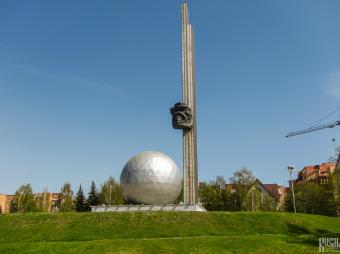
600th Anniversary of Kaluga Monument
- opposite 13 Ulitsa Gagarina
Kaluga celebrated its 600th anniversary in 1971 and in commemoration of this a new monument was unveiled on the road into the city from the bridge over the River Oka. It consists of a 50 metre obelisk with a sculpture of a cosmonaut which stands next to a giant sphere in honour of Kaluga being called the cradle of cosmonautics. Also included are bas reliefs of Konstantin Tsiolkovsky and significant events in the city’s history. Read more »
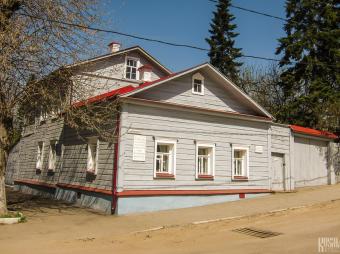
Konstantin Tsiolkovsky House-Museum
- 79 Ulitsa Tsiolkovskogo
- http://www.gmik.ru/dom_en.html
- 9:30 - 17:00 (Wednesdays: 11:00 - 19:00). Closed on Mondays and the last Friday of the month.
The house where Konstantin Tsiolkovsky lived for 29 years and where he wrote many of his most important scientific papers is now a house-museum dedicated to him and a memorial filial of the Museum of Cosmonautics. Tsiolkovsky died in 1935 and the museum was opened a year later in 1936. Although the museum was damaged during the Nazi occupation, the interior of the building has been restored to how it looked when Tsiolkovsky lived there and displays his actual belongings and… Read more »
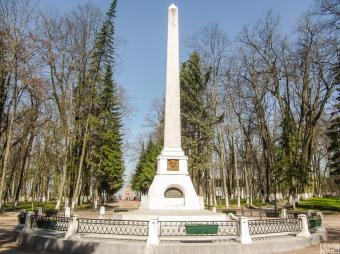
Konstantin Tsiolkovsky's Grave
- Park imeni Tsiolkovskogo
Park imeni Tsiolkovskogo (Tsiolkovsky Park) was developed in the 18th century and there are lime (linden) trees there which are over 200 years old here. It was a favourite place for Tsiolkovsky to walk around and in 1935 upon the death of the great scientist it was unanimously decided to bury him in the park and to rename it in his honour. A 12.5 metre obelisk was later erected over the grave where Tsiolkovsky was laid to rest. Read more »
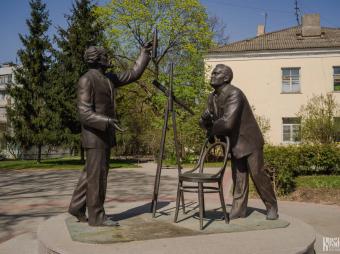
Meeting of Konstantin Tsiolkovsky and Sergey Korolev Monument
- intersection of Ulitsa Tsiolkovskogo and Ulitsa Akademika Koroleva
On a corner where Ulitsa Tsiolkovskogo and Ulitsa Akademika Koroleva meet, there is a monument which depicts an imagined meeting between the streets' namesakes: Konstantin Tsiolkovsky, the founding father of Russian theoretical cosmonautics and Sergei Korolev, the founding father of Russian practical cosmonautics. Read more »
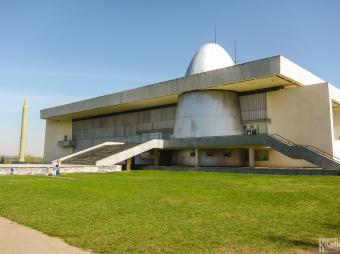
Museum of Cosmonautics
- Ulitsa Akademika Koroleva
- http://www.gmik.ru/index_en.html
- 9:30 - 17:00 (Wednesdays: 11:00 - 19:00). Closed on Mondays and the last Friday of the month.
The Museum of Cosmonautics, or the Konstantin Tsiolkovsy State Museum of the History of Cosmonautics to give it its full name, is Kaluga's most famous sight. It was decided to build the museum in Kaluga upon the insistence of Sergey Korolev in recognition of the contribution of Konstantin Tsiolkovsky in the Soviet Space Race. In 1961 Yuri Gagarin laid the building's cornerstone and the museum was officially opened in 1967. The museum has exhibitions on the history of aeronautics… Read more »
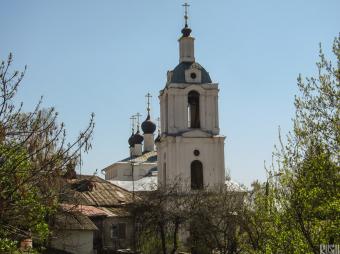
Transfiguration of the Lord Church
- 8 Ulitsa Smolenskaya
This church is usually also referred to in Russian as the Higher Transfiguration of the Lord Church as it is located on the top of the ravine. It was built in 1700 to replace an older wooden version. It is made up of a white stone building topped with five small black domes and attached to a small bell tower. It was closed in 1938 and only reopened in 1993. Now it serves as an embassy church for the Svyato-Pafnutiev Monastery in Borovsk. Read more »
North of the City
Svyato-Lavrentiev Monastery
- 49 Ulitsa Shirokaya
According to legend, the Svyato-Lavrentiev Monastery was founded in 1515 by Prince Simeon of Kaluga. It was established around a wooden church dedicated to the Resurrection where St Laurentius (Lavrenti) of Kaluga had been buried. St Laurentius was a holy fool who was known for walking around barefooted and in light clothing all year round. He is credited with saving the city in 1512 when he warned the prince of an approaching Crimean Tatar army. During the Times of Troubles the… Read more »


 History
History